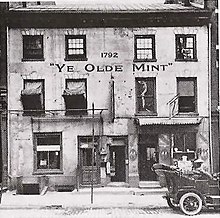| Revision as of 02:20, 16 April 2023 edit2001:1970:5065:d100::9e7d (talk)No edit summaryTags: Reverted Mobile edit Mobile web edit← Previous edit | Revision as of 02:20, 16 April 2023 edit undoClueBot NG (talk | contribs)Bots, Pending changes reviewers, Rollbackers6,439,108 editsm Reverting possible vandalism by 2001:1970:5065:D100:0:0:0:9E7D to version by 2A00:23C4:6B13:D801:85C5:3FB:C4B8:6C68. Report False Positive? Thanks, ClueBot NG. (4233154) (Bot)Tag: RollbackNext edit → | ||
| Line 2: | Line 2: | ||
| ] | ] | ||
| ], as it appeared around 1908]] | ], as it appeared around 1908]] | ||
| "'''Ye olde |
"'''Ye olde'''" is a pseudo–] phrase originally used to suggest a connection between a place or business and ] (or the ]). The term dates to 1896 or earlier;<ref name="gizmodo">{{cite web |last1=Davis |first1=Lauren |title="Ye Olde" Is Fake Old English (And You're Mispronouncing It Anyway) |url=https://io9.gizmodo.com/ye-olde-is-fake-old-english-and-youre-mispronouncing-1679780566 |website=Gizmodo |access-date=18 September 2019 |date=15 January 2015 |archive-date=4 September 2019 |archive-url=https://web.archive.org/web/20190904034815/https://io9.gizmodo.com/ye-olde-is-fake-old-english-and-youre-mispronouncing-1679780566 |url-status=live }}</ref> it continues to be used today, albeit now more frequently in an ironically ] and ] fashion.<ref name="gizmodo" /> | ||
| ==History== | ==History== | ||
Revision as of 02:20, 16 April 2023
Pseudo Early Modern English phrase

"Ye olde" is a pseudo–Early Modern English phrase originally used to suggest a connection between a place or business and Merry England (or the medieval period). The term dates to 1896 or earlier; it continues to be used today, albeit now more frequently in an ironically anachronistic and kitsch fashion.
History
See also: English articles: Ye form
The use of the term ye to mean "the" derives from Early Modern English, in which the was written þe, employing the Old English letter thorn, ⟨þ⟩. During the Tudor period, the scribal abbreviation for þe was þͤ or þᵉ ; here, the letter ⟨þ⟩ is combined with the letter ⟨e⟩. With the arrival of movable type printing, the substitution of ⟨y⟩ for ⟨Þ⟩ became ubiquitous, leading to the common ye as in "Ye Olde Curiositie Shoppe." One major reason for this was that ⟨y⟩ existed in the blackletter types that William Caxton and his contemporaries imported from Belgium and the Netherlands, while ⟨Þ⟩ did not, resulting in ![]() (yͤ) as well as y. The connection became less obvious after the letter thorn was discontinued in favour of the digraph ⟨th⟩. Today, ye is often incorrectly pronounced as the archaic pronoun of the same spelling.
(yͤ) as well as y. The connection became less obvious after the letter thorn was discontinued in favour of the digraph ⟨th⟩. Today, ye is often incorrectly pronounced as the archaic pronoun of the same spelling.
See also
References
- ^ Davis, Lauren (15 January 2015). ""Ye Olde" Is Fake Old English (And You're Mispronouncing It Anyway)". Gizmodo. Archived from the original on 4 September 2019. Retrieved 18 September 2019.
- Merriam-Webster Online Dictionary, Archived 2012-10-20 at the Wayback Machine ye retrieved February 1, 2009
- Hill, Will (30 June 2020). "Chapter 25: Typography and the printed English text" (PDF). The Routledge Handbook of the English Writing System. p. 6. ISBN 9780367581565.
The types used by Caxton and his contemporaries originated in Holland and Belgium, and did not provide for the continuing use of elements of the Old English alphabet such as thorn <þ>, eth <ð>, and yogh <ʒ>. The substitution of visually similar typographic forms has led to some anomalies which persist to this day in the reprinting of archaic texts and the spelling of regional words. The widely misunderstood 'ye' occurs through a habit of printer's usage that originates in Caxton's time, when printers would substitute the <y> (often accompanied by a superscript <e>) in place of the thorn <þ> or the eth <ð>, both of which were used to denote both the voiced and non-voiced sounds, /ð/ and /θ/ (Anderson, D. (1969) The Art of Written Forms. New York: Holt, Rinehart and Winston, p 169)
External links
- Antique English: Why is 'ye' used instead of 'the' in antique English?
- THE versus YE: historical data from English spelling 1450-1734